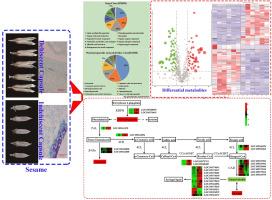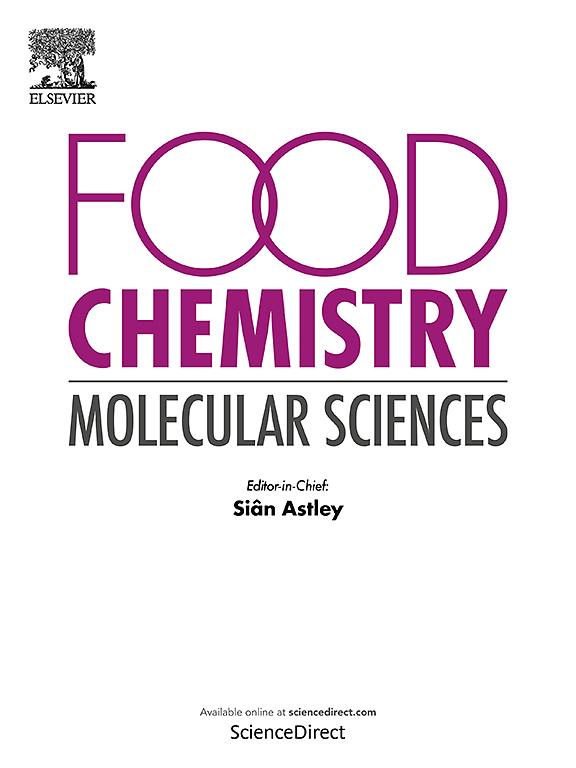成熟芝麻开裂与不开裂蒴果代谢差异及分子机制
IF 4.1
Q2 FOOD SCIENCE & TECHNOLOGY
引用次数: 0
摘要
芝麻蒴果在收获前的损失对机械化生产造成了重大的经济挑战。参与胶囊闭合的代谢物尚不清楚。采用比较代谢组学和转录组学分析方法,研究了芝麻两种类型灭裂胶囊万致28 (ND)和灭裂胶囊万致2 (WZ2)的分子调控和富集途径。结果表明,木质素合成相关通路的基因和代谢物显著富集。此外,数据表明脂质和糖代谢可能对胶囊闭合有影响。除了其在细胞信号传导中的功能外,后者可能有助于木质素单体的糖基化,而前者可能为细胞微管运动提供ATP。本工作同时关注了大量与芝麻荚膜抗裂机制相关的差异表达转录因子,为荚膜开裂功能标记和基因的发现和利用提供了新的证据。关键途径和调控机制的确定为制定减轻收获过程中种子损失的策略提供了有价值的信息,最终有助于提高芝麻生产的效率和利润。本文章由计算机程序翻译,如有差异,请以英文原文为准。

Metabolite differences and molecular mechanism between dehiscent and indehiscent capsule of mature sesame
The loss of sesame capsule seed prior to harvest poses a significant economical challenge in mechanized production. The metabolites involved in capsule closure are still unclear. Using comparative metabolome and transcriptome analysis, this work investigated the molecular regulation and enrichment pathways in two sesame types of indehiscent capsule WanZhi28 (ND) and dehiscent capsule WanZhi2 (WZ2). The findings demonstrated that genes and metabolites were significantly enriched in lignin synthesis-related pathways. Furthermore, data suggests that lipid and sugar metabolism may have an impact on capsule closure. Apart from its function in cell signaling, the latter may contribute to the glycosylation of lignin monomers, while the former may provide ATP for cellular microtubule movement. This work concurrently focused on a large number of differentially expressed transcription factors linked to the sesame capsule's anti-cleft mechanism, providing new evidence for the discovery and use of functional markers and genes for capsule dehiscence. The identification of key pathways and regulatory mechanisms offers valuable information for developing strategies to mitigate seed loss during harvest, ultimately contributing to more efficient and profitable sesame production.
求助全文
通过发布文献求助,成功后即可免费获取论文全文。
去求助
来源期刊

Food Chemistry Molecular Sciences
Agricultural and Biological Sciences-Food Science
CiteScore
6.00
自引率
0.00%
发文量
83
审稿时长
82 days
期刊介绍:
Food Chemistry: Molecular Sciences is one of three companion journals to the highly respected Food Chemistry.
Food Chemistry: Molecular Sciences is an open access journal publishing research advancing the theory and practice of molecular sciences of foods.
The types of articles considered are original research articles, analytical methods, comprehensive reviews and commentaries.
Topics include:
Molecular sciences relating to major and minor components of food (nutrients and bioactives) and their physiological, sensory, flavour, and microbiological aspects; data must be sufficient to demonstrate relevance to foods and as consumed by humans
Changes in molecular composition or structure in foods occurring or induced during growth, distribution and processing (industrial or domestic) or as a result of human metabolism
Quality, safety, authenticity and traceability of foods and packaging materials
Valorisation of food waste arising from processing and exploitation of by-products
Molecular sciences of additives, contaminants including agro-chemicals, together with their metabolism, food fate and benefit: risk to human health
Novel analytical and computational (bioinformatics) methods related to foods as consumed, nutrients and bioactives, sensory, metabolic fate, and origins of foods. Articles must be concerned with new or novel methods or novel uses and must be applied to real-world samples to demonstrate robustness. Those dealing with significant improvements to existing methods or foods and commodities from different regions, and re-use of existing data will be considered, provided authors can establish sufficient originality.
 求助内容:
求助内容: 应助结果提醒方式:
应助结果提醒方式:


